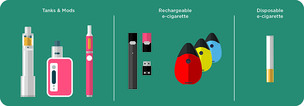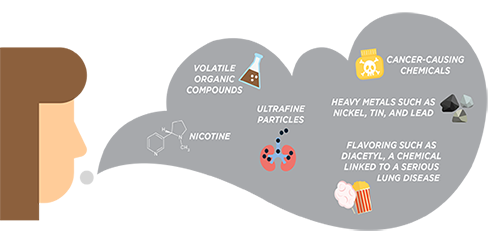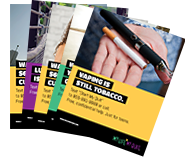NEWS RELEASE | Sept 20, 2019
The Centers for Control and Prevention (CDC), U.S. Food and Drug Administration, state and local health departments, and other clinical and public health partners are investigating a multistate outbreak of severe pulmonary disease associated with e-cigarette product use (devices, liquids, refill pods and cartridges).
As of September 17, 2019, 530 cases have been reported to the CDC, with seven confirmed deaths. All reported cases have a history of using e-cigarette or vaping products. Most patients have reported a history of using e-cigarette products containing THC. Many patients have reported using THC and nicotine. Some have reported the use of e-cigarette products containing only nicotine. The investigation has not identified any specific e-cigarette product or substance that is linked to all cases. No consistent evidence of an infectious cause has been discovered. Therefore, the suspected cause is a chemical exposure.
The CDC has received complete sex and age data on 373 of 530 cases.
- Nearly three fourths (72%) of cases are male
- Two thirds (67%) of cases are 18 to 34 years old
- 16% of cases are under 18 years and 17% are 35 years or older
Patients in this investigation have reported symptoms such as:
- cough, shortness of breath or chest pain
- nausea, vomiting or diarrhea
- fatigue, fever or abdominal pain
"We are learning more as this outbreak investigation continues," stated Dr. Paul Heidel, medical director at the Ottawa County Department of Public Health. "E-cigarettes and vaping products can contain nicotine. Nicotine is harmful and can cause long-term health effects. If you use these products and are experiencing symptoms, please contact your primary care provider."
Consider not using e-cigarette or vaping products. If you do and you experience symptoms like those reported in this outbreak, seek medical care.
Regardless of the ongoing investigation:
- Youth, young adults and pregnant women should not use e-cigarette or vaping products.
- Adults who do not currently use tobacco products should not start using them, particularly e-cigarette or vaping products.
- If you do use e-cigarette or vaping products, you should not buy these products off the street or products with THC or other cannabinoids.
- You should not modify e-cigarette or vaping products or add any substances to these products that are not intended by the manufacturer.
- Adult smokers who are attempting to quit should use evidence-based treatments, including counseling and FDA-approved medications. If you need help quitting tobacco products, including e-cigarettes, contact your doctor and see the quit smoking resources below.

E-cigarettes are devices that deliver an aerosol to the user by heating a liquid that usually contains nicotine, flavorings and other chemicals. E-cigarettes can also be used to deliver marijuana or other substances.
|

It is difficult for consumers to know what e-cigarette products contain. For example, some e-cigarettes marketed as containing zero percent nicotine have been found to contain nicotine.
The e-cigarette aerosol that users breathe from the device and exhale can contain harmful and potentially harmful substances, including:
- Nicotine
- Ultrafine particles that can be inhaled deep into the lungs
- Flavoring such as diacetyl, a chemical linked to a serious lung disease
- Volatile organic compounds
- Cancer-causing chemicals
- Heavy metals such as nickel, tin and lead
|
Most e-cigarettes contain nicotine, which has known health effects.
 |
|
- Nicotine is highly addictive.
- Nicotine is toxic to developing fetuses.
- Nicotine is a health danger for pregnant women
and their developing babies.
- Nicotine can harm adolescent brain development,
which continues into the early to mid-20s.
|
 |
|
Besides nicotine, e-cigarette aerosol can contain substances that harm the body. This includes cancer-causing chemicals and tiny particles that reach deep into lungs.
E-cigarettes can cause unintended injuries. Defective e-cigarette batteries have caused fires and explosions, some of which have resulted in serious injuries.
|
 |
|
Most explosions happened when the e-cigarette batteries were being charged. In addition, acute nicotine exposure can be toxic. Children and adults have been poisoned by swallowing, breathing or absorbing e-cigarette liquid through their skin or eyes. |
 |
|
E-cigarettes are not currently approved by the FDA as a quit smoking aid. The U.S. Preventive Services Task Force (a group of health experts that makes recommendations about preventive health care) has concluded that evidence is insufficient to recommend e-cigarettes for smoking cessation in adults, including pregnant women.
|
Nearly 1 in 3 Ottawa County teenagers have used an electronic vapor product.
Nearly half of Ottawa County teenagers believe there is no or slight risk to using electronic vapor products.
"In Ottawa County, more than a third of teens report having used an electronic vapor product at least once; and by 12th grade, nearly half of teens report having vaped," said Derel Glashower, senior epidemiologist at the Ottawa County Department of Public Health. "Because vaping is so common among teens, parents should have a conversation with their kids about the potential health risks."
Talk with Your Teen About E-cigarettes: A Tip Sheet for Parents

Resources for Youth
A local resource for parents and schools to access information about substance use prevention.
- Help with starting conversations and open communications
- Learn about the latest information on emerging drugs
- See what is going on in your community
- Know how to spot signs and symptoms of drug use
A youth quit tobacco and vaping program that offers free and confidential help from a quit coach specially trained to listen to teens, help teens navigate social situations that involve tobacco or vaping and find healthy ways to cope with stress.
My Life, My Quit offers:
- The first comprehensive program designed just for teens
- Teen focused messages and educational materials created with youth input
- Five real-time coaching sessions via live text messaging, online chat or phone
- On-going text messages for encouragement throughout the quit process
- A watermarked certificate of completion of the program can be given to school administrators
- A great program schools can offer as an alternative to suspension

Download and print My Life, My Quit posters
to display in classrooms and schools.
|
MEDIA CONTACT:
Kristina Wieghmink
616-494-5597 or kwieghmink@miottawa.org
LOCAL DATA SOURCES:
Ottawa County 2017 Behavioral Risk Factor Survey, page 73
Ottawa County 2017 Youth Assessment Survey, page 26
OUTBREAK SOURCES:
The New England Journal of Medicine - "Pulmonary Illness Related to E-Cigarette Use in Illinois and Wisconsin - Preliminary Report"
MMWR - "Severe Pulmonary Disease Associated with Electronic-Cigarette-Product Use - Interim Guidance"
US Department of Health and Human Services - E-cigarette use among youth and young adults: A report of the Surgeon General.
|